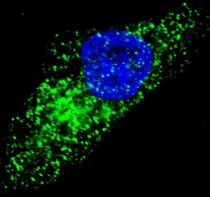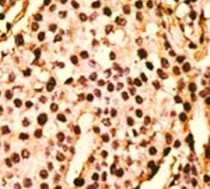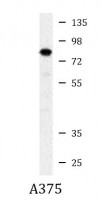ARG54825
anti-ATG9A antibody
anti-ATG9A antibody for ICC/IF,IHC-Formalin-fixed paraffin-embedded sections,Western blot and Human
Cancer antibody; Cell Biology and Cellular Response antibody; Cell Death antibody; Metabolism antibody; Neuroscience antibody
Overview
| Product Description | Rabbit Polyclonal antibody recognizes ATG9A |
|---|---|
| Tested Reactivity | Hu |
| Tested Application | ICC/IF, IHC-P, WB |
| Host | Rabbit |
| Clonality | Polyclonal |
| Isotype | IgG |
| Target Name | ATG9A |
| Antigen Species | Human |
| Immunogen | KLH-conjugated synthetic peptide corresponding to aa. 717-746 (C-terminus) of Human ATG9A. |
| Conjugation | Un-conjugated |
| Alternate Names | APG9L1; MGD3208; APG9-like 1; mATG9; Autophagy-related protein 9A |
Application Instructions
| Application Suggestion |
|
||||||||
|---|---|---|---|---|---|---|---|---|---|
| Application Note | * The dilutions indicate recommended starting dilutions and the optimal dilutions or concentrations should be determined by the scientist. | ||||||||
| Positive Control | A375 |
Properties
| Form | Liquid |
|---|---|
| Purification | This antibody is prepared by Saturated Ammonium Sulfate (SAS) precipitation followed by dialysis against PBS. |
| Buffer | PBS and 0.09% (W/V) Sodium azide |
| Preservative | 0.09% (W/V) Sodium azide |
| Storage Instruction | For continuous use, store undiluted antibody at 2-8°C for up to a week. For long-term storage, aliquot and store at -20°C or below. Storage in frost free freezers is not recommended. Avoid repeated freeze/thaw cycles. Suggest spin the vial prior to opening. The antibody solution should be gently mixed before use. |
| Note | For laboratory research only, not for drug, diagnostic or other use. |
Bioinformation
| Database Links | |
|---|---|
| Gene Symbol | ATG9A |
| Gene Full Name | autophagy related 9A |
| Function | Involved in autophagy and cytoplasm to vacuole transport (Cvt) vesicle formation. Plays a key role in the organization of the preautophagosomal structure/phagophore assembly site (PAS), the nucleating site for formation of the sequestering vesicle. Cycles between a juxta-nuclear trans-Golgi network compartment and late endosomes. Nutrient starvation induces accumulation on autophagosomes. Starvation-dependent trafficking requires ULK1, ATG13 and SUPT20H. [UniProt] |
| Cellular Localization | Cytoplasmic vesicle, autophagosome membrane; Multi-pass membrane protein. Golgi apparatus, trans-Golgi network membrane; Multi-pass membrane protein. Late endosome membrane; Multi-pass membrane protein. Endoplasmic reticulum membrane; Multi-pass membrane protein. Note=Under amino acid starvation or rapamycin treatment, redistributes from a juxtanuclear clustered pool to a dispersed peripheral cytosolic pool. The starvation- induced redistribution depends on ULK1, ATG13, as well as SH3GLB1 |
| Research Area | Cancer antibody; Cell Biology and Cellular Response antibody; Cell Death antibody; Metabolism antibody; Neuroscience antibody |
| Calculated MW | 94 kDa |
Images (3) Click the Picture to Zoom In
-
ARG54825 anti-ATG9A antibody ICC/IF image
Immunofluorescence: U251 cells were treated with Chloroquine (50 µM, 16h), then fixed with 4% PFA (20 min), permeabilized with Triton X-100 (0.2%, 30 min). Cells were then stained with ARG54825 anti-ATG9A antibody (green) at 1:100 dilution, 2 h at room temperature. Nuclei were counterstained with Hoechst 33342 (blue) (10 µg/ml, 5 min). ATG9A immunoreactivity is localized to autophagic vacuoles in the cytoplasm of U251 cells.
-
ARG54825 anti-ATG9A antibody IHC-P image
Immunohistochemistry: Formalin-fixed and paraffin-embedded Human breast cancer tissue stained with ARG54825 anti-ATG9A antibody.
-
ARG54825 anti-ATG9A antibody WB image
Western blot: 35 µg of A375 cell lysate stained with ARG54825 anti-ATG9A antibody.








